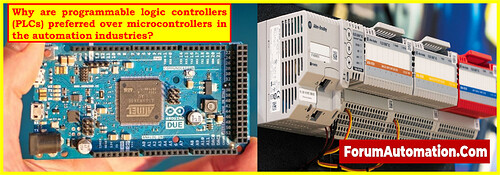Microcontrollers are also used in automation industries for specific applications where their advantages are beneficial. However, they have some limitations that make PLCs more preferred in many automation scenarios:
Cost
Microcontrollers are generally more cost-effective than PLCs, making them suitable for budget-conscious projects or applications with simpler control requirements.
Small Scale
Microcontrollers are often used in small-scale or standalone systems, where the control and monitoring tasks are relatively simple and do not require extensive I/O or complex logic.
Customization
Microcontrollers offer more customization options, allowing developers to tailor the hardware and software to specific application requirements, which can be advantageous for niche projects.
Embedded Systems
Microcontrollers are commonly used in embedded systems, where control functions are integrated directly into devices like household appliances, consumer electronics, and automotive systems.
Real-time Performance
Some microcontrollers are optimized for real-time control and can handle time-critical tasks efficiently. However, this often depends on the specific microcontroller and its capabilities.
Low Power Consumption
Microcontrollers are designed to operate with low power consumption, making them suitable for battery-operated and energy-efficient applications.
Rapid Prototyping
Microcontrollers are popular for rapid prototyping and development due to their simplicity and quick setup, allowing engineers to test ideas and concepts before implementing them on a larger scale.
Custom Logic and Algorithms
Microcontrollers enable developers to implement custom control algorithms and logic, which may not be as straightforward in PLCs.
Despite these advantages, microcontrollers have some limitations compared to PLCs, which is why PLCs are preferred in many automation industries:
Reliability and Robustness
PLCs are designed to operate in harsh industrial environments, where they can withstand temperature variations, humidity, electrical noise, and vibrations. They are built with industrial-grade components, ensuring higher reliability and longer operational lifespans compared to microcontrollers.
Real-time Operation
PLCs are specifically optimized for real-time control and monitoring tasks. They have dedicated hardware and firmware to execute logic quickly and precisely, making them ideal for time-critical automation processes.
I/O Scalability
PLCs offer a wide range of Input/Output (I/O) modules, allowing for easy scalability and expansion to accommodate varying automation needs. This flexibility makes them suitable for both small and large-scale industrial applications.
Standardization
PLCs adhere to industry standards like IEC 61131-3, which provides a unified programming environment. This standardization ensures compatibility, consistency, and ease of programming across different PLC brands and models.
User-Friendly Programming
PLC programming is usually done using ladder logic or other graphical programming languages, which are easier to understand and maintain for control engineers and technicians. This simplicity helps reduce the learning curve and speeds up the development of automation applications.
Built-in Communication Protocols
PLCs come with built-in communication protocols like Modbus, Profibus, Ethernet/IP, etc., enabling seamless integration with other industrial devices, such as Human-Machine Interfaces (HMIs), SCADA systems, and Distributed Control Systems (DCS).
Safety Features
PLCs often include built-in safety features, such as watchdog timers, redundancy, and secure memory storage. These safety measures are crucial in ensuring the reliable and safe operation of critical automation systems.
Diagnostics and Troubleshooting
PLCs provide extensive diagnostics capabilities that allow engineers to monitor the system’s health, detect faults, and troubleshoot issues quickly. This helps reduce downtime and ensures efficient maintenance.
Centralized Control
PLCs offer centralized control, allowing users to program and manage complex processes from a single controller. This centralized approach simplifies system design, reduces wiring, and streamlines maintenance.
Long-Term Support
PLC manufacturers typically provide long-term support for their products, including software updates, spare parts availability, and technical assistance. This support ensures the longevity and sustainability of automation systems.
While microcontrollers have their advantages in certain applications, such as smaller scale and low-cost projects, PLCs remain the preferred choice in automation industries due to their specialized features, reliability, scalability, and ease of use in demanding industrial environments.
